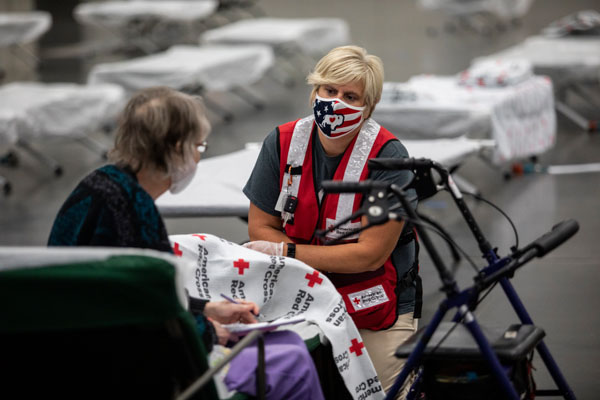
FILE: Emily Girard of the American Red Cross speaks with Sue Barnes at an American Red Cross shelter at the Oregon Convention Center in Portland, Ore., on Monday, Sept. 14, 2020, after Barnes evacuated because of wildfires burning throughout the region.
Scott Dalton
Wildfires can break out at a moment’s notice and spread quickly into communities, causing significant damage, injuries and even death.
According to the World Health Organization, wildfires across the globe are increasing in frequency and severity.
Recently, several states including Oregon have seen record-breaking wildfire seasons, with millions of acres burning each year. As a new wildfire season begins, officials are urging people to plan ahead and take precautions early.
Emergency responders say staying informed, creating an evacuation plan, and knowing what essential items to pack can help save your life.
Creating a wildfire evacuation plan
FEMA’s Ready campaign, which was created to help families prepare for natural disasters and emergencies, suggests getting ahead of potential disasters by knowing what’s common in your area.
In the Pacific Northwest, earthquakes, winter storms and wildfires are among the region’s more common natural disasters. Understanding what potential emergencies you might face will help keep you informed and ready.
- Create a plan with family members, friends or people in your household for who to contact and where to go should a wildfire break out.
- Check in with your neighbors and exchange information.
- Make transportation arrangements ahead of potential emergencies.
- Opt-in to get to emergency alerts and notices from your county.
- Map out possible evacuation routes by checking TripCheck.com or calling 511.
- Create a list of emergency contacts. This can also be included in your emergency kit.
- Identify emergency shelters in your area by contacting the American Red Cross.
- Practice your plan with your household and friends or neighbors.
- Have an emergency kit ready and packed with essential supplies. It’s also important to maintain your kit and check on it once or twice a year for items that need to be replaced.
How to make a wildfire emergency kit
The Oregon Department of Emergency Management recommends packing an emergency kit that is easy to carry and includes essential supplies for your health, safety and identification.
- Critical medications (seven-day supply) and other medical items.
- Sanitation items, including a first-aid kit, gloves and face coverings.
- Non-perishable food and water. One gallon per person, per day or a three-day supply for evacuations.
- Whistles, flashlights and extra batteries.
- Battery-powered or hand-crank radio.
- Blankets, extra clothing and shoes.
- Copies of important documents like photo IDs, birth certificates and mortgage deeds or rental agreements, as well as insurance policies.
- Phones, charging cords and other important hard drives or backup devices.
- Cash, credit cards or traveler’s checks.
- Consider the needs of family members, such as infant or animal care, and pack supplies accordingly.
- Personal hygiene items.
- Maps of the area.
Understanding evacuation levels
Know Your Evacuation Levels 🚨
— OregonOEM (@OregonOEM) May 27, 2025
When wildfire strikes, every second counts. Be ready to act by understanding Oregon’s evacuation levels:
🔴 Level 3 – GO NOW
🟡 Level 2 – BE SET
🟢 Level 1 – BE READY pic.twitter.com/D0vDL6VYi0
In Oregon, law enforcement officials will issue evacuation orders using a three-level system to inform and alert residents of potential danger. Officials suggest after evacuating to wait until further instructions from law enforcement who will determine when it is safe to return.
- Level 1 — “Be Ready” — Prepare to evacuate, be aware of danger in your area. This includes having your emergency kit ready and ensuring those in your household who are considered vulnerable are ready to evacuate if needed.
- Level 2 — “Be Set” — Be set to evacuate at a moment’s notice, due to significant danger in your area. Officials will issue this order when there is significant wildfire danger nearby. For those needing extra time, voluntary evacuation is encouraged.
- Level 3 — “Go Now!” — Leave immediately, due to extreme danger in your area. This order means it is unsafe to remain in place, and that emergency responders may not be able to help.
Stay safe and informed during wildfire season with OPB’s wildfire guide at opb.org/wildfires. This resource offers essential safety tips and preparedness guidance to help you navigate fire and smoke events. This resource was created as part of our commitment to serving the public as wildfire seasons become longer and more dangerous.
Related: How to prepare for wildfire smoke
Related: Fire season glossary